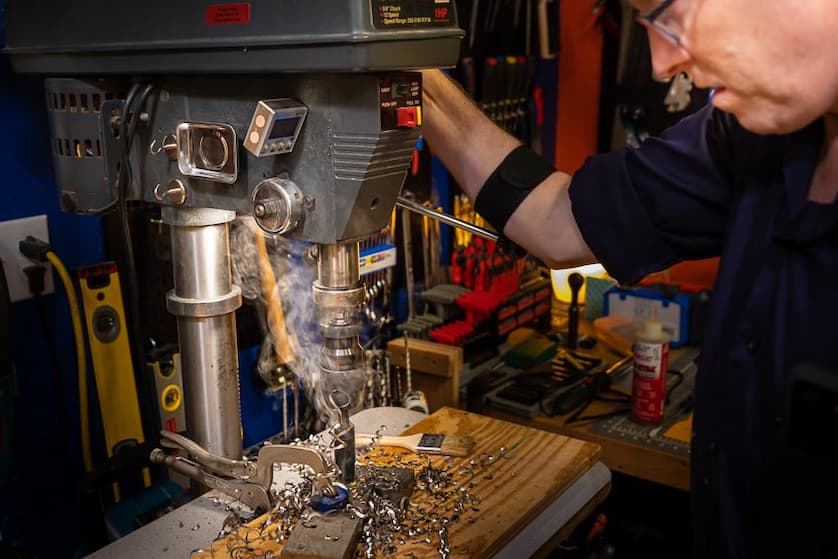A productive metalworking workspace depends on the tools you rely on every day. The right setup not only improves efficiency but also helps maintain safety, accuracy, and workflow across projects. Whether you’re managing a large-scale operation or working on custom builds, investing in essential tools can streamline tasks and reduce downtime.
From cutting and shaping to measuring and finishing, each tool plays a role in keeping your work consistent and professional. If you’re building or upgrading your space, here are the must-have tools every metalworker should have on hand.
Drill Press
A reliable drill press is one of the most important tools in any metalworking space. It delivers clean, consistent holes with precision that’s hard to achieve using a handheld drill. The ability to drill at specific depths and angles makes it a go-to machine for professionals who need accuracy and repeatability across projects.

Whether you’re working on custom parts or large-scale fabrication, this type of machine helps maintain quality and reduce errors. There are two main types of drill presses: benchtop and floor models. Benchtop versions are work bench models, compact, lightweight, and ideal for small workshops or lighter tasks. Floor models offer more power and capacity, making them better suited for regular, heavy-duty use.
Choosing the right drill press depends on your requirements. Naturally, the model you invest in should fit your workspace and project needs, improve productivity, and help you get the results you want. Here’s what to keep in mind:
- Material type: If you mostly work with soft metals like aluminium or brass, a lighter-duty machine will work. For harder metals such as steel or cast iron, look for a more powerful model with high torque.
- Hole size and depth: For small, shallow holes, a compact unit will do. On the other hand, for larger or deeper holes, you should choose a machine with more power and a longer column.
- Speed settings: Having multiple spindle speeds lets you adjust the machine for different metals, which helps achieve cleaner results and extends the life of your tools.
- Throat depth: This determines how far from the edge you can drill; larger pieces need a greater throat depth.
- Added features: Adjustable tables, cross-slide vices, chuck guards, and safety switches can all make your work easier and safer.
With the right drill press machine, you’ll gain better control, improved accuracy, and more consistent results on every project.
Bandsaw
The bandsaw is a key tool in metalworking shops, known for its versatility and precision. It uses a continuous, toothed metal blade stretched between two wheels, allowing it to make clean, accurate cuts in metal.
Bandsaws come in two main types: horizontal and vertical. A vertical bandsaw lets you slide metal over the blade to create curves and angled cuts, while a horizontal bandsaw holds the metal in place and cuts it to length.
When investing in a bandsaw, make sure features like blade width, tooth type, and cutting depth match your projects. Also, consider adding accessories such as rip fences for straight cuts or mitre gauges for angled cuts to enhance its versatility and performance.
Angle Grinder
An angle grinder is a versatile and essential tool for any productive metalworking workspace. It features a high-speed rotating disc that can cut, grind, polish, and clean metal surfaces, making it highly valuable for daily tasks. Angle grinders come in various sizes and power sources, including electric corded, cordless, and pneumatic models.
For extended use, a corded grinder is ideal, while cordless options offer excellent portability. Pneumatic grinders deliver strong performance but require an air compressor. Choosing the right discs for your specific jobs will maximise efficiency and help maintain a clean, professional finish.
Press Brake
A press brake is a vital tool in metalworking shops, mainly used for bending sheet metal with precision and flexibility. It works by pressing metal placed on a die with a punch to shape it. Press brakes come in different types:

- Hydraulic: Offers strong force but less accuracy;
- Pneumatic: Makes for fast operation, but is less powerful;
- Electric: Provides high accuracy with lower force; initially more expensive but requires less upkeep;
- Mechanical: Uses a flywheel for force and has a simpler design, but may have safety concerns.
Choosing the right press brake involves considering size, tonnage, and operation mode. Also, investing in accessories like dies, backgauges, and safety features can boost efficiency and protect operators.
Milling Machine
A milling machine is a key tool in metalworking and manufacturing, used to shape solid materials like metal and wood. It works by rotating cutting tools to remove material and can handle everything from simple cuts to complex shapes. Milling machines come in different types, such as horizontal, vertical, turret, and bed mills, each suited to specific jobs.
When choosing one, consider the machine’s size, power, and features like CNC control for better accuracy and automation. Accessories like vices, end mills, and digital readouts help improve precision, while automatic tool changers and cooling systems increase productivity.












